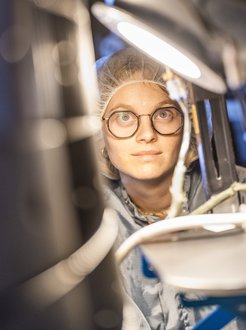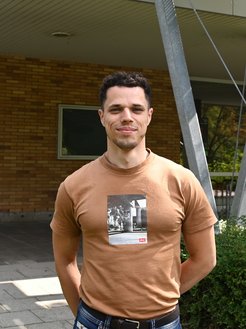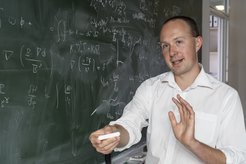
Ever built a star?
Is it possible to rely on a clean, sustainable, and universally available energy source in the future? Is it possible to ignite the fire of the stars here on Earth? At the Max Planck Institute for Plasma Physics in Garching near Munich and in Greifswald (Germany), this is exactly what we aim to achieve: researching the physical foundations for a fusion power plant. This means that one day we will be able to harness the energy of the stars here on Earth.
To achieve this goal, we need dedicated young researchers who will work with us to make fusion energy a reality. In short: We need you! If you have a passion for physics, engineering, material sciences or computer science and are ready to push the boundaries of knowledge, then you are the right person for us.
At our two sites in Greifswald and Garching, you will find excellent research conditions with world leading fusion devices and ideal supervision from renowned researchers. The proximity to the vibrant metropolis of Munich and the rich cultural life of the old university town of Greifswald complete our program.
What our PhD students and Postdocs say

Hannah Lindl, PhD student since 2024
Hannah is using plasma spectroscopy to investigate how heat dissipation can be optimized in ASDEX Upgrade.
“I wrote my Master's thesis at IPP and was impressed by how intensively young researchers are supervised and supported here. I always had the feeling that I was seen and that my experienced colleagues were interested in my work. For example, we get the opportunity to present at conferences early on. I quickly realized that I wanted to stay at IPP for my doctoral thesis. Also because fusion is a matter close to my heart: when I gave a presentation on fusion research in the 11th grade, I enjoyed physics for the first time. And that's why I started studying in the first place.”

Joey Rubin, PhD student since 2023
Joey works in the Neutral Beam Injection group and supports the development of negative ion sources for ITER.
“I’ve always been into science, especially into physics. When I was younger I wanted to study astrophysics and this was my first contact with plasma physics. Over time, my interest shifted towards fusion plasma and fusion technology in general. As this includes tokamaks, I knew about ASDEX Upgrade and thus the IPP.
I joined the IPP for a lot of reasons, first and foremost because of the good environment both in terms of work and outside. I had (and still have) a really nice contact with supervisors and the team, that are supportive. There are many people doing a lot of interesting work at IPP, so it’s a great place to connect and collaborate. The combination of the science, the people and the city makes me really happy to be here.
What I like about Munich is that it’s a vibrant and human-sized city, with plenty of things to do. It’s also close to nature, which is perfect for activities like hiking and skiing. Overall, I’m very satisfied with both my work and personal life here.”

Francesco Franco, PhD student since 2024
Francesco is currently working in the Plasma Gas Conversion Group, where he focusses on chemical reactions in plasma to convert gases, such as the synthesis of ammonia or the conversion of CO_2 into CO. In particular, he works in the characterization of plasma using spectroscopy.
“I did my Bachelor’s and Master’s degree in Padua in plasma physics and in particular in fusion research, so the IPP has always been on my map.
Apart from the scientific activities and the strong collaboration between my former university and the IPP, the proximity to Italy as well as the quality of life in Munich and its surroundings were also big factors. I live next to Englischer Gartern, which is very nice in summer. But also, with its Museums, the night life and of course the Alps nearby, Munich is a very enjoyable place.”

Bob Davies, postdoc since 2023
Bob works in the Stellarator Theory department in Greifswald, and is researching divertor design for stellarator power plants.
“After graduating from my undergraduate studies, I worked for a year in industry, before coming back into academia via a PhD at the University of York, England. I had liked the idea of fusion energy ever since I learned about it in high school, and so researching plasma physics for fusion seemed like a way of making a childhood dream come true. I greatly enjoyed the PhD and so decided to continue as a postdoc. I chose the IPP because it has a good reputation for world-leading plasma physics and gave me an opportunity to live abroad. What I like best about the IPP is the supportive work environment and having the academic freedom to research whatever I feel is important and/or interesting. As a place to live, Greifswald is little, but lovely, and is handily very near to the sea. Since moving here, I’ve taken up kite surfing, which I highly recommend!”
Explore our research in theory and experiment
The ASDEX Upgrade tokamak in Garching is a cutting-edge device allowing us to study high-temperature plasmas under conditions similar to those in future fusion reactors such as the international fusion experiment ITER. The flexibility of ASDEX Upgrade’s magnetic configurations allows optimization of plasma confinement, stability, and energy output. By testing advanced materials and simulating extreme conditions, it helps solve the challenges of fusion energy.
The Wendelstein 7-X stellarator in Greifswald is paving the way toward clean, sustainable energy. As the largest and most advanced stellarator in the world, Wendelstein 7-X explores the stability and confinement of plasma – crucial steps for achieving practical fusion power. With its innovative design, Wendelstein 7-X provides key insights into how to sustain fusion conditions over long periods of time.
Established in 2012, the division Numerical Methods in Plasma Physics is developing new computational methods for fusion research. This includes numerical methods describing the complex plasma behaviour, fast software for high performance computers and visualisation methods for the large quantities of data involved.
Boost your scientific career right now!
Application for your Doctorate at our graduate school HEPP
Further information about HEPP
Application for your Postdoc position
Further information about the Career Center for Postdocs
Postdoctoral positions in the ASDEX Upgrade Project
Selected research topics
PhD Positions Focused on the Development of Tungsten-Copper Composite Materials for Highly Loaded Plasma-Facing Components
In the divertor region of future magnetic confinement fusion devices, so-called plasma-facing components (PFCs) will have to sustain intense particle and heat fluxes reliably during fusion operation. Furthermore, possible material choices are for such components limited and decade-long fusion related materials and plasma-wall interaction research has concluded that divertor PFCs will have to be made out of a tungsten armour facing the fusion plasma, as well as a copper based heat sink part. Against this background, tungsten-copper composites (such as tungsten fibre-reinforced materials) or composite structures based on novel fabrication technologies (such as additive manufacturing) can be exploited in order to realise advanced divertor PFC designs with improved performance and durability. Several PhD positions are currently available in the context of this topical field.
Contact person: Alexander von Müller
Postdoc position in Experimental Physics for Neutral Beam Injection on the ASDEX Upgrade Tokamak
On ASDEX Upgrade Neutral Beam Injection (NBI) is the work horse among the heating systems and employed in the majority of discharges. Precise knowledge of the parameters of the injected beams from the recently modernised NBI injectors is an important prerequisite for discharge analysis and simulation. The candidate will contribute to improving automated beam characterisation on a shot-to-shot basis by using all available beam diagnostics in an integrated data analysis approach. Besides, the candidate will contribute to the experimental programme on ASDEX Upgrade as an NBI operator and advisor for experiments using NBI and have the opportunity to engage in the physics programme of ASDEX Upgrade through own experiment proposals.
Contact person: Christian Hopf
Postdoc position: Optical Emission Spectroscopy at a Source for Negative Hydrogen Ions
Neutral beam injection (NBI) is an established method for heating a fusion plasma. For ITER two NBI beam lines are foreseen, based on the generation, extraction and acceleration of negative hydrogen or deuterium ions. Operative at IPP are two test facilities for the NBI ion sources of the ITER NBI system. One of the diagnostic methods used for improving the physics insight is optical emission spectroscopy (OES), i.e. the detection of light in the visible wavelength range. We offer a PhD position on performing OES at sources for negative ions and interpreting the results via population models.
Contact person: Dirk Wünderlich
For a detailed list of possible research topics click here.



